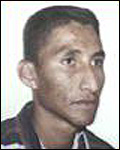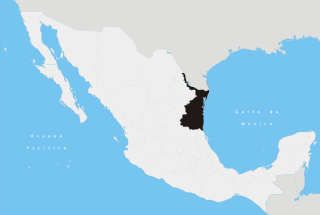Related Research Articles
Operation Tijuana or Operation Baja California of the Government of Mexico is taking place in Tijuana and the surrounding areas of Baja California and Baja California Sur. This operation is part of the Joint Operation Against Drug Trafficking.

Operation Michoacán is a joint operation by Federal Police and the Mexican military to eliminate drug plantations and to combat drug trafficking. Initiated on December 11, 2006, the operation was supervised by The Secretary of Public Safety, Attorney General of Mexico, Secretary of the Interior, Mexican Navy and Mexican Army.

The Morelia grenade attacks took place on 15 September 2008 on the occasion of the Mexican Independence Day anniversary when thousands of people were gathered in the Plaza Melchor Ocampo, the main square of the Mexican city of Morelia, Michoacán. Shortly after the Grito in that city, led by Governor Leonel Godoy, two grenades were thrown into the crowds, killing at least eight people and injuring more than 100.
The timeline of some of the most relevant events in the Mexican drug war is set out below. Although violence between drug cartels had been occurring for three decades, the Mexican government held a generally passive stance regarding cartel violence through the 1980s and early 2000s.

Joint Operation Nuevo León-Tamaulipas is an anti-drug joint operation in two Mexican states of Tamaulipas and Nuevo León by Federal Police and the Mexican Armed Forces. The objective of the joint operation is to eliminate Los Zetas and Gulf Cartel operations in the area. So far, many cartel members have been either killed or arrested. Recently Los Zetas and the Gulf Cartel have broken relations and started fighting each other.
Coordinated Operation Chihuahua or formerly known as Joint Operation Chihuahua is a Military and Federal Police operation started in 2008 by the Mexican Army and Policía Federal Preventiva. The objective is to "besiege" Ciudad Juárez to concentrate forces and saturate the area to confront the three cartels already operating in the city. Ciudad Juárez is known to be one of the most dangerous cities in the Americas. In the year 2007 more than 100 police officers were killed in Juárez in attacks blamed on organized crime. As a result of drug cartel violence, President Felipe Calderón has previously launched other Joint Operations in other states.
The Beltrán Leyva Organization (BLO), also known as the Beltrán Leyva Cartel; Spanish: Cártel de los Beltrán Leyva (CBL), was a Mexican drug cartel and organized crime syndicate, formerly headed by the five Beltrán Leyva brothers: Marcos Arturo, Carlos, Alfredo, Mario Alberto, and Héctor. Founded as a Sinaloa Cartel, the Beltrán Leyva cartel was responsible for transportation and wholesaling of cocaine, heroin and marijuana. It controlled numerous drug trafficking corridors, and engaged in human smuggling, money laundering, extortion, kidnapping, murder and gun-running.

Antonio Ezequiel Cárdenas Guillén, commonly referred to by his alias Tony Tormenta, was a Mexican drug lord and co-leader of the Gulf Cartel, a drug trafficking organization based in Tamaulipas. He headed the criminal group along with Jorge Eduardo Costilla Sánchez. Antonio was considered by Mexican security forces as one of Mexico's most-wanted men.
Operation Sinaloa or Operation Culiacan - Navolato is an ongoing anti-drug trafficking operation in the Mexican state of Sinaloa by the Federal Police and the Mexican Armed Forces. Its main objective is to cripple all cartel organizations such as the Sinaloa Cartel, Beltrán-Leyva Cartel and Los Zetas that operate in that state. The Military was deployed in response to the murder of Mexico's Federal Police commissioner Édgar Eusebio Millán Gómez.

Timeline of Mexican Naval anti-drug cartel operations during the Mexican drug war are listed below:
Arnoldo Rueda Medina is a former Mexican drug lord and high-ranking leader of La Familia Michoacana, a drug trafficking organization which is based in Michoacán, Mexico.
Barrio Azteca, or Los Aztecas, is a Mexican-American street and prison gang originally based in El Paso, Texas, USA and Ciudad Juarez, Chihuahua, Mexico. The gang was formed in the Coffield Unit, located near Tennessee Colony, Texas by Jose "Raulio" Rivera, a prisoner from El Paso, in the early 1980s. It expanded into a transnational criminal organization that traded mainly across the US-Mexico border. Currently one of the most violent gangs in the United States, they are said to have over 3,000 members across the country in locations such as New Mexico, Texas, Massachusetts, and Pennsylvania as well as at least 5,000 members in Ciudad Juarez, Mexico.

The Jalisco New Generation Cartel or CJNG, is a Mexican criminal syndicate, based in Jalisco and headed by Nemesio Oseguera Cervantes. The cartel has been characterized by extreme violence and public relations campaigns. Though the CJNG is known for diversifying into various criminal rackets, drug trafficking remains its most profitable activity. The cartel has been noted for cannibalizing some victims during the training of new sicarios or members, as well as using drones and rocket-propelled grenades to attack enemies.
Gonzalo Inzunza Inzunza, commonly referred to by his alias El Macho Prieto, was a Mexican suspected drug lord and high-ranking leader of the Sinaloa Cartel, a criminal group based in Sinaloa, Mexico. He worked as the cartel's assassins chief under the tutelage of Ismael "El Mayo" Zambada and as the regional leader of the cartel in the states of Baja California and Sonora. His base of operations was in Mexicali, where he coordinated marijuana and cocaine shipments through the Calexico–Mexicali border region. On 18 December 2013, Inzunza was killed in a shootout with Mexican authorities in the resort area of Puerto Peñasco, Sonora. Before the gunfight was over, several of his gunmen took the corpse of the drug lord with them.

Héctor Manuel Sauceda Gamboa, commonly referred to by his alias El Karis, was a Mexican suspected drug trafficker and high-ranking leader of the Gulf Cartel, a drug trafficking organization based in Tamaulipas. He was the brother of the drug lord Gregorio Sauceda Gamboa, another high-ranking drug trafficker who worked under the tutelage of Osiel Cárdenas Guillén, the former top leader of the cartel. El Karis took the lead of the Gulf Cartel in Reynosa following the arrest of Jaime González Durán, a leader of Los Zetas drug cartel, in November 2008.

On May 22, 2015, a three-hour shootout broke out between the Mexican Federal Police and alleged members of the Jalisco New Generation Cartel (CJNG) in Ecuandureo, Michoacán, leaving 43 dead. One of the fatalities was a Federal Police officer, while the others were suspected to be organized crime members. The confrontation started when the Federal Police spotted a suspicious vehicle on a highway in Tanhuato, Michoacán. The authorities had received information that one of the properties in the area had been overrun by criminals. Unconfirmed reports suggested that the CJNG leader Nemesio Oseguera Cervantes was in the area. When they tried to pull over the vehicle, however, the men onboard opened fire at the police units. A vehicle chase ensued and the security forces made their way into a large, rural property where the shootout intensified. The Federal Police then called for ground and air reinforcements and neutralized the situation.

On 6 April 2015, a convoy of the Jalisco State Police was ambushed by suspected members of the Jalisco New Generation Cartel (CJNG), a criminal group based in Jalisco. The attack occurred in a mountain road in San Sebastián del Oeste, Jalisco. Fifteen policemen were killed and five were wounded; no CJNG casualties were confirmed. According to police reports, as the police convoy reached a part of the road surrounded by mountains, the CJNG opened fire at the police units from the sides using high-caliber rifles, grenade launchers, and explosives with gasoline. The element of surprise prevented the police from repelling the aggression. The CJNG members burned several vehicles along the highway to halt reinforcements. The attack lasted roughly 30 minutes. When government reinforcements reached the scene, the CJNG gunmen had left.

On 19 March 2015, a convoy of the National Gendarmerie, a subdivision of the Mexican Federal Police (PF), was ambushed by gunmen of the Jalisco New Generation Cartel (CJNG), a criminal group based in Jalisco, Mexico. The attack occurred in a residential neighborhood in Ocotlán, Jalisco. Five policemen, four CJNG gunmen, and two civilian bystanders were killed. According to police reports, as the PF convoy pulled up next to a parked vehicle, gunmen shot at them from the vehicle and from rooftops. The police attempted to shield themselves using their patrol cars, but reinforcements from the CJNG arrived at the scene and overwhelmed them. The shootout lasted between thirty minutes to two hours before the CJNG fled the scene.

On 9 November 1999, two agents from the United States Drug Enforcement Administration (DEA) and Federal Bureau of Investigation (FBI) were threatened at gunpoint and nearly killed in Matamoros, Tamaulipas, Mexico, by gunmen of the Gulf Cartel, a criminal group based in the area. The two agents traveled to Matamoros with an informant to gather intelligence on the operations of the Gulf Cartel. As they cruised through one of the properties owned by the criminal group, they noticed several vehicles following them. The agents were forced to a stop and were corralled by a convoy of eight vehicles, from which fifteen gunmen emerged and surrounded the agents' car. Some of them wore uniforms of the local police. Among the gunmen was the former kingpin Osiel Cárdenas Guillén, who recognized the informant and ordered the three of them to get out of their vehicle.
The Santa Rosa de Lima Cartel or CSRL is a Mexican criminal organization from the state of Guanajuato. Founded in 2014, it was initially headed by "The Sledgehammer". They mainly earn their income from oil theft. In June 2020, it was reported that state government raids and turf wars with the Jalisco New Generation Cartel resulted in the Santa Rosa de Lima losing much of their territories in Guanajuato, Querétaro and Hidalgo and all of their "soldiers." However, cartel members still maintain a small presence in certain municipalities of Guanajuato, such as Villagrán, though they are not active in organized crime. Ortiz was captured by state and federal authorities on 2 August 2020 along with 5 other people.
References
- 1 2 3 4 5 At least 14 killed in Mexico attacks, CNN News, August 7, 2009, retrieved 2009-08-07
- ↑ Associated Press (August 7, 2009), Shootouts between police, gunmen in central Mexico leave at least a dozen dead, Star Tribune, archived from the original on August 13, 2009, retrieved 2009-08-07
- ↑ Associated Press (August 7, 2009), Shootouts in Mexico leave at least 11 dead, archived from the original on August 13, 2009, retrieved 2009-08-07